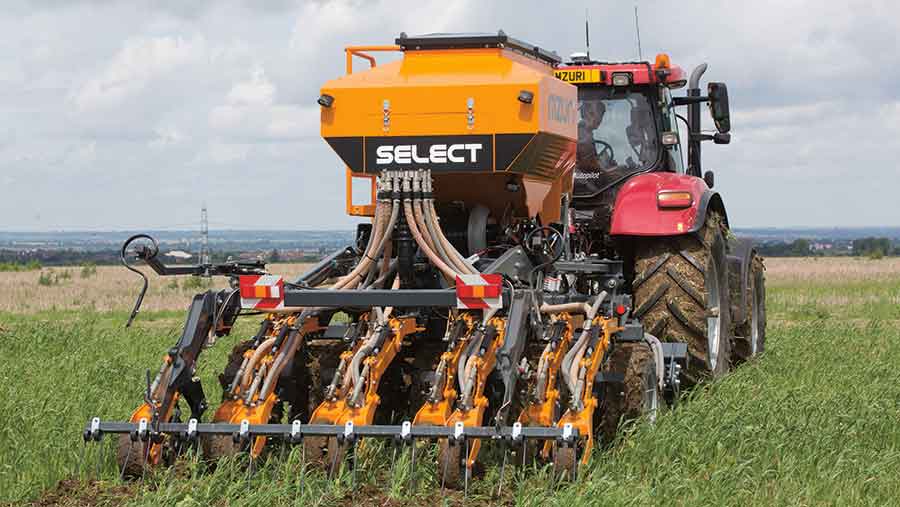Strip-till innovation doubles soil organic matter

Switching to a strip tillage approach has substantially increased soil organic matter and improved heavy clay soils on the Worcestershire farm owned by machinery innovator Martin Lole.
Strip drilling direct into stubbles has overcome poor soil structure caused by ploughing and excessive cultivation, reduced capital investment in machinery and cut labour costs.
It has also increased yields, adding to gains in profit margin, says Mr Lole.
See also: 12 no-till drills on show at farmer-organised demo day
“Over the six years we have been strip drilling, average wheat yield has grown from 7.3t/ha at a cost of £200t/ha for a plough-based system according to John Nix Farm Management figures, to a yield of 12t/ha costing £72/ha to establish,” he says.
“We’ve seen big improvements in soil and plant health, with a 25mm layer of organic matter providing huge biodiversity,” Mr Lole adds.
“It’s an approach that’s not only profitable but also reliable, compared with direct drilling, which I regard as risky.”
Having acquired land to create his current 178ha property, he was struck by how good the soil structure was on the last of the blocks of land, which had been farmed mainly for stock, compared with the two that had been farmed intensively for arable production.
That had a marked influence on his approach to land preparation for crops.
“I also thought back to the way my father farmed; he rarely ploughed and wouldn’t have a power harrow on the farm,” he says.
“He lightly cultivated the surface and then broadcast seed and harrowed it in, which resulted in decent yields and very low machinery capital and running costs.”
Better understanding
Looking to emulate that, but with today’s technology and a better understanding of the soil environment, Mr Lole experimented unsuccessfully using a subsoiler with seed coulters before thinking through the soil-working processes required and designing what would become the Mzuri Pro-til strip drill, now produced commercially on the farm.
Key elements of this implement are the residue clearing and cultivating front tines, press wheels to consolidate the resulting tilth, band sowing tine coulters and pressure-adjustable press wheels.
This combination provides strips of firm tilth clear of straw at the surface for easy sowing and to prevent nitrogen lock-up in the vicinity of the young plants, and with intact soil and straw in between.
“Over six years since we stopped ploughing and introduced strip drilling, organic matter has doubled and we have significantly higher numbers of earthworms, plus the presence of beneficial fungi, bacteria and fine roots,” notes Mr Lole.
In addition to the drill, key measures introduced since ditching the plough and conventional cultivation are a four-year rotation with about a quarter of the farmed area put to spring cropping to spread the workload and provide grassweed control opportunities.
Sowing cover crops immediately behind the combine in fields destined for a spring crop also make a contribution.
“Cover crops produce a fantastic root structure and turn sunlight into energy that’s absorbed into the soil as organic matter once frosts or a dose of glyphosate kill them off,” he points out.
“Above the ground, the plants suppress weeds and volunteers, and protect the soil surface against erosion, while also providing a marvellous resource for bees and other insects.”
In similar vein, he is enthusiastic about keeping as much straw as possible on the surface to contribute organic matter, prevent water-borne soil erosion, minimise surface evaporation to retain moisture in the upper soil, and to feed a growing population of soil fauna.
“Incorporating straw by overall cultivation destroys the important microclimate in the top 20mm where you have a ready-made seed-bed rich in fauna,” he says.
“It’s best to just leave the stubble standing and the straw intact on the surface; nature will do the rest.”
No appreciable damage
The Pro-til seeder operates roughly 30deg off the permanent tramlines used for all other operations to avoid drilling in the same direction and in the same place year after year. With low ground pressure tyres travelling on a high proportion of untilled soil and a supportive mat of straw, he is confident that the one set of wheelings is not doing any appreciable damage.
Good timing and patience are also required: “It’s essential to keep off these heavy clay soils when they’re wet, and to then allow natural restructuring through the wetting-drying-wetting process as far as possible,” he says.
Latest developments for the Pro-til shown at the recent Groundswell event add to the implement’s versatility.
The Select system – which is optional on all models except the 6m trailed machine where it is standard – makes use of the hydraulic break-back cylinders to lift alternate leading tines and coulters out of work, resulting in wider row spacing for oilseed rape and cover crops.
Although the operator needs to change the lid of the distribution head to set up the correct tramlining, lifting the tines involves nothing more than flicking a switch and the drill’s control box automatically compensates for the new sowing width of the machine.
A low disturbance tine coulter provides a new direct drilling option with single or twin coulters – the latter giving 166mm spacing on an 18-row drill – with precision sowing units a new add-on for maize.
Each of the US-sourced seeding units has a mini hopper topped up from the drill’s main hopper, and GPS-regulated electric drive avoids overlaps where rows converge.

Select versions of the Mzuri Pro-til strip drill can lift alternate tines and coulters out of work for wider-spaced sowing of crops such as oilseed rape and cover crops

Twin tine direct drilling coulter assembly – operated with all the leading tines lifted out of work – is a new option to extend the Pro-til’s versatility…

…as is the precision sowing version, which has electrically-driven seeding units mounted on the coulter assemblies.
These new developments will be demonstrated during Mzuri’s first appearance at the Tillage-Live event at Monks Kirby, Warwickshire, in September.

